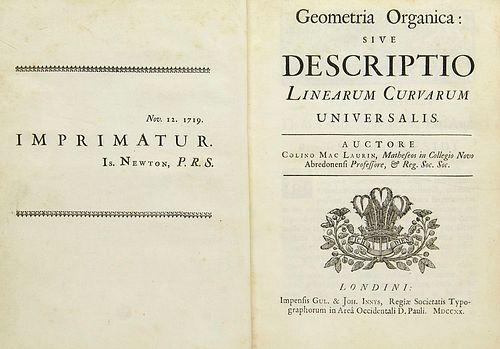Mac Laurin, Colin Geometrica Organica: Sive Descriptio Linearum Curvarum Universalis. Mit 12 gefalteten Kupfertafeln. London, Gul. & Joh. Innys, 1720.
Lot 1499
Categories
Absentee vs Live bid
Two ways to bid:
- Leave a max absentee bid and the platform will bid on your behalf up to your maximum bid during the live auction.
- Bid live during the auction and your bids will be submitted real-time to the auctioneer.
Bid Increments
| Price | Bid Increment |
|---|---|
| EUR€0 | EUR€10 |
| EUR€100 | EUR€10 |
| EUR€200 | EUR€20 |
| EUR€300 | EUR€30 |
| EUR€420 | EUR€30 |
| EUR€480 | EUR€20 |
| EUR€500 | EUR€50 |
| EUR€2,000 | EUR€200 |
| EUR€3,200 | EUR€300 |
About Auction
By Jeschke Jádi Auctions Berlin GmbH
Jul 31, 2021
Set Reminder
2021-07-31 06:00:00
2021-07-31 06:00:00
America/New_York
Bidsquare
Bidsquare : Rare Books, Prints, Historical Photography (Auction 138, Session 2)
https://www.bidsquare.com/auctions/jeschke-van-vliet/rare-books-prints-historical-photography-auction-138-session-2-7234
Session 2: Lot 882-1765 Jeschke Jádi Auctions Berlin GmbH info@jvv-berlin.de
Session 2: Lot 882-1765 Jeschke Jádi Auctions Berlin GmbH info@jvv-berlin.de
- Lot Description
Mathematik Mac Laurin, Colin Geometrica Organica: Sive Descriptio Linearum Curvarum Universalis. Mit 12 gefalteten Kupfertafeln. London, Gul. & Joh. Innys, 1720. Kl.-4°. (6), 139 (1: errata) S. HLdr. d. 19. Jhs. mit gold gepr. RTitel. Mathematics. - Very rare first edition. With 12 folded copper sheets. Contemporary half leather binding. No copy currently available for us in international trade, only 5 copies at auctions since 1945. - The Geometrica Organica is dedicated to Isaac Newton, whom MacLaurin, a Scot, had met, and deals with the conics and curves of higher levels. It provides proofs for important theorems described by Newton, without proofs, and some of MacLaurin's own theorems. Maclaurin (1698-1746) was a British mathematician.1719 he visited London, where he met Isaac Newton and was accepted into the Royal Society. From 1726 he became professor in Edinburgh, where he stayed for the rest of his career, recommended by Newton. 1740 he again won the prize of the Academie des Sciences (together with Euler and Daniel Bernoulli) with a work about tides. He was the inventor of the Trisektrix series, named after him, and of the Maclaurin series, named after him (in his treatise on fluxions), which is only a special case of the Taylor series (Maclaurin also refers to Taylor). He was also involved in the development of the Euler-Maclaurin formula (which appeared in his Treatise) and established the Maclaurin inequality. Partly slightly browned - a good copy of this very rare book. Bruneau, Le Delinearum de Mac Laurin: entre Newton et Poncelet (2011). - Zur Zeit kein Exemplar im internationalen Handel für uns nachweisbar, nur 5 Exemplare auf Auktionen seit 1945. - Sehr seltene erste Ausgabe. Die Geometrica Organica ist Isaac Newton gewidmet, den MacLaurin, ein Schotte, kennen gelernt hatte. Die Schrift befasst sich mit den Koniken und den Kurven höherer Ebenen. Sie liefert Beweise für wichtige von Newton beschriebene Theoreme, ohne Beweise, sowie einige von MacLaurins eigenen Theoremen. Maclaurin (1698-1746) war ein britischer Mathematiker. 1719 besuchte er London, wo er Isaac Newton traf und in die Royal Society aufgenommen wurde. Ab 1726 wurde er mit einer Empfehlung von Newton Professor in Edinburgh, wo er den Rest seiner Karriere blieb. 1740 erhielt er erneut den Preis der Academie des Sciences (gemeinsam mit Euler und Daniel Bernoulli) mit einer Arbeit über Gezeiten. Er war Erfinder der nach ihm benannten Trisektrix und der nach ihm benannten Maclaurinsche Reihe (in seinem Treatise on fluxions), die allerdings nur einen Spezialfall der Taylorreihe darstellt (Maclaurin nimmt auch Bezug auf Taylor). Zudem war er an der Entwicklung der Euler-Maclaurin-Formel beteiligt (die in seinem Treatise vorkam) und stellte die Maclaurin-Ungleichung auf. - Teils etwas gebräunt. Gutes Exemplar der seltenen Schrift.
- Buyer's Premium



 EUR
EUR CAD
CAD AUD
AUD GBP
GBP MXN
MXN HKD
HKD CNY
CNY MYR
MYR SEK
SEK SGD
SGD CHF
CHF THB
THB













